American Film Manufacturing Company
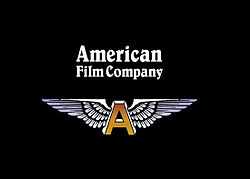
The American Film Manufacturing Company (aka Flying "A" Studios)[1] was an American motion picture production company, known as Flying "A" Studios. In 1915, the formal name was changed to the American Film Company.[1]
History
The company was founded in Chicago, Illinois, in the fall of 1910,[1] by Samuel S. Hutchinson, John Freuler, Charles J. Hite and Harry Aitken, four mid-western businessmen who joined forces and capital to create the American Film Manufacturing company.
Flying "A" Studios was located in La Mesa, California, from August 12, 1911 to July 6, 1912, using filming locations in La Mesa, other East County areas such as Lakeside, in addition to sites around San Diego.[2]
Under the leadership of Allan Dwan, Flying "A" made over 150 films in San Diego County. The films were usually western adventures, comedies or an occasional local documentary. The Flying A westerns were popular with the public and kept Dwan and his crew extremely busy. The Dwan westerns gave the Flying A the ability to mount large advertising campaigns, create additional films, and become a player in the motion picture industry. While mostly filming in the backcountry near La Mesa, some sets were built behind the Flying A Studios. Dwan would occasionally film a cowboy chase scene and then build a plot around that chase. Dwan's troupe of actors became very popular with the public.[3]
In August 1912, Flying "A" Studios established its western branch in Santa Barbara. Prior to this, three shooting companies were created. Two would work at the studio or surrounding locales of Chicago, while it was the third unit that was sent out to concentrate on westerns. This western unit would move through the southwest with stops in New Mexico, Arizona and finally California.
The third unit would eventually settle in the town of La Mesa before moving Northwest to Santa Barbara. The reasons for the move to California had a lot to do with weather,[4] and even more to do with avoiding the constraints of the "Edison Trust" (i.e., The Motion Picture Patents Company or MPPC) operating in Chicago and New York.[5] The main reason for choosing Santa Barbara before La Mesa was that the American Film Company wanted to have urban backdrops in some of its movies.[6]
During its operation between 1912 and 1917, Flying "A" Studios was one of the largest motion picture studios in the United States.[7] At the time, this made Santa Barbara a film making center rivaled only by Hollywood.
Gallery
- 1916 advertisements
-
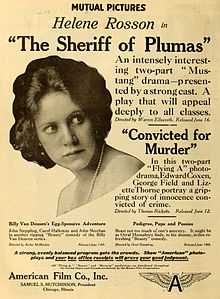
-
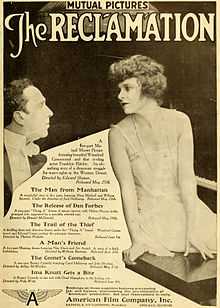
-
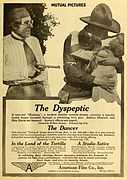
-
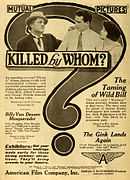
-
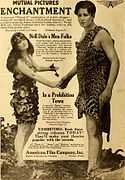
-
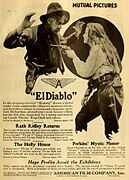
Notable Actors or Actresses

The American Film Company had many great movie stars during their years located in Santa Barbara. One of the greatest, if not the greatest was Mary Miles Minter. Minter, born Juliet Reilly, April 1, 1902 – August 4, 1984, was one of the most successful in her genre as a silent film actress. She did her first featured film in 1915, as Viola Drayton in the The Fairy and the Waif. She did her last role as an actress in 1923 in The Trail of the Lonesome Pine. She left the movie industry at only age 22 after a scandal involving her and director William Desmond Taylor. Even though she wasn’t in the movie industry for more than eight years, she made more than 50 movies and her contributions to the motion picture industry gave her a star on the Hollywood Walk of Fame at 1724 Vine Street.[8]
The Conclusion
The World War, the great influenza epidemic of 1918-19 and the depression of 1921 all played a part in bringing an end to the American Film Company and its Santa Barbara studio. Yet other film companies survived, primarily because they had chosen to invest in theaters, providing a built in consumer for their product. American lost its primary distributor when Mutual folded in 1918 and although the company's product continued to be well regarded, the Flying A found itself on the outside looking in with no direct link to the public. [1]
Bibliography
- Birchard, Robert S. Silent-era filmmaking in Santa Barbara, Charleston, SC: Arcadia, c2007. ISBN 0-7385-4730-1.
- Lawton, Stephen. Santa Barbara’s Flying A studio, Santa Barbara, Calif.: Fithian Press, 1997. ISBN 1-56474-210-5.
- Lyons, Timothy J. The silent partner: the history of the American Film Manufacturing Company, 1910-1921, New York: Arno Press, 1974 [c1972]. ISBN 0-405-04872-6.
- Slide, Anthony. The American Film Industry: A Historical Dictionary. New York: Limelight Editions, 1990. p. 17. ISBN 0-87910-139-3.
- Tompkins, Walker A. Santa Barbara History Makers. McNally & Loftin, Santa Barbara. 1983. ISBN 0-87461-059-1.
References
- ↑ 1.0 1.1 1.2 1.3 "filmandmedia.ucsb.edu". Retrieved 2009-02-23.
- ↑ "LA MESA RESIDENT SEEKS TO REVIVE CITY’S SILENT MOVIE HERITAGE FOR CENTENNIAL".
- ↑ "FILMING SAN DIEGO, Hollywood's Backlot, 1898-2002".
- ↑ Lawton, Stephen: Santa Barbara’s Flying A studio, Santa Barbara, Calif.: Fithian Press, 1997 p 130.
- ↑ Lawton p 17.
- ↑ "filmandmedia.ucsb.edu". Retrieved 2009-02-23.
- ↑ Lawton p 130.
- ↑ Lawton p 78.
External links
- "Filmography as Production Company". Retrieved 2009-02-23.
- "American Film Company". Retrieved 2009-02-23.
- "Flying A Studios". Retrieved 2009-02-17.
- "Documentary May Lift Visibility of Flying 'A'". Retrieved 2009-02-17.